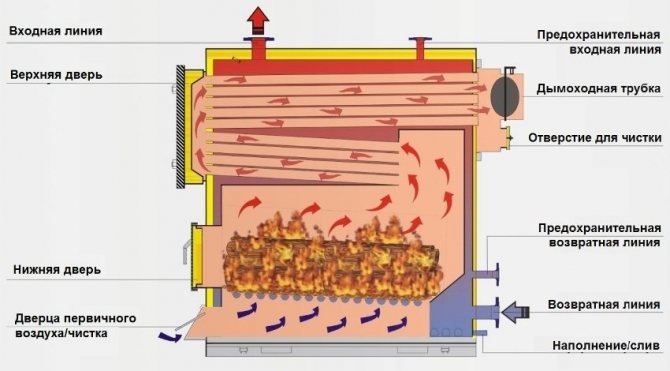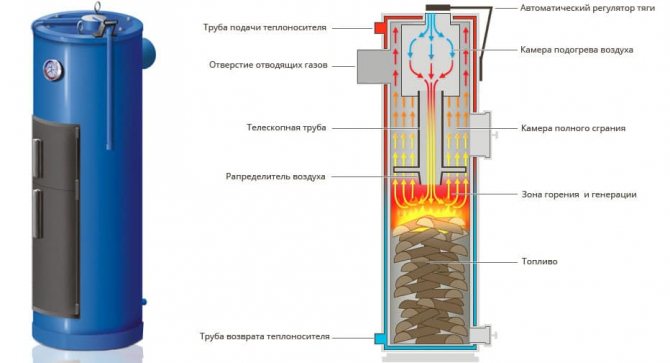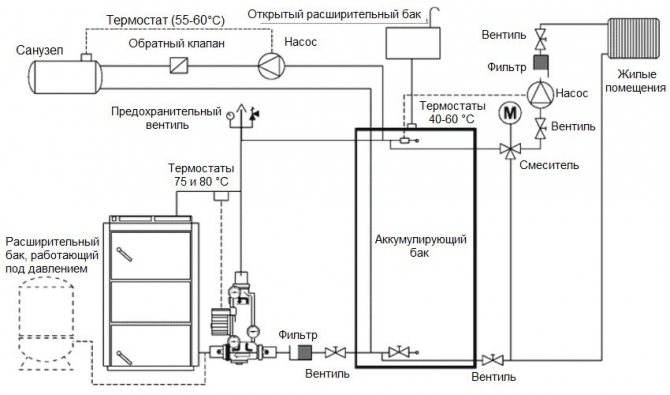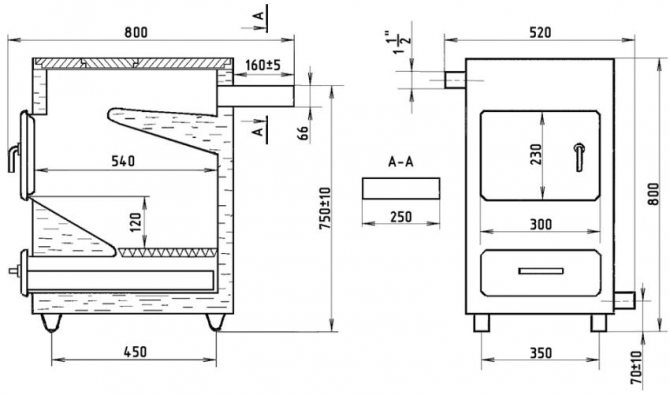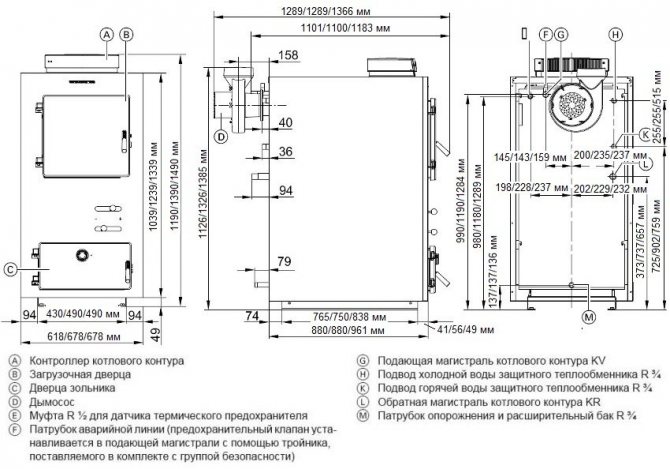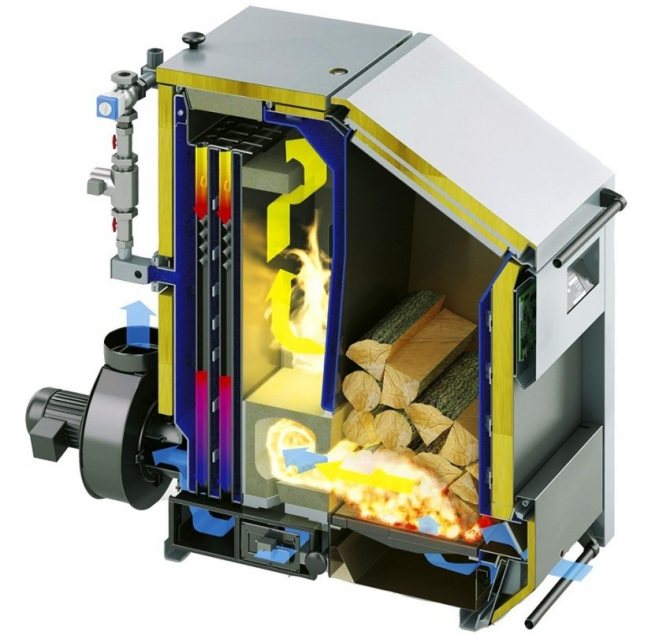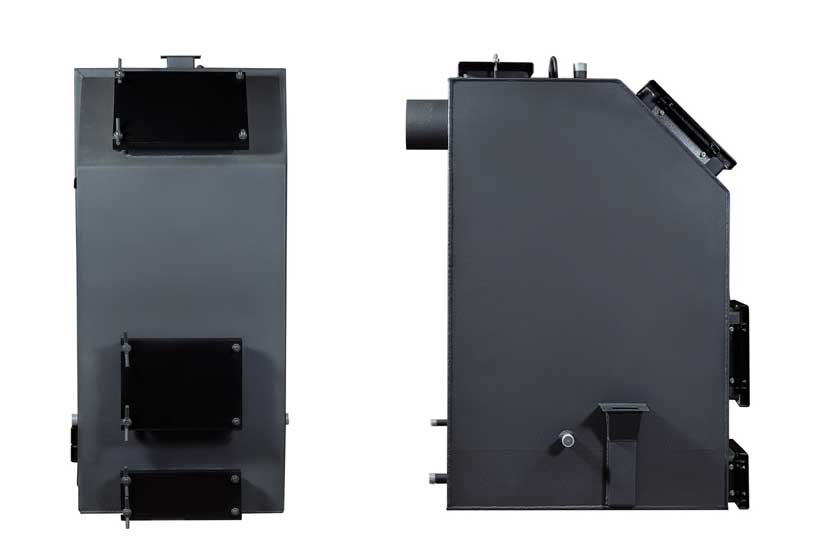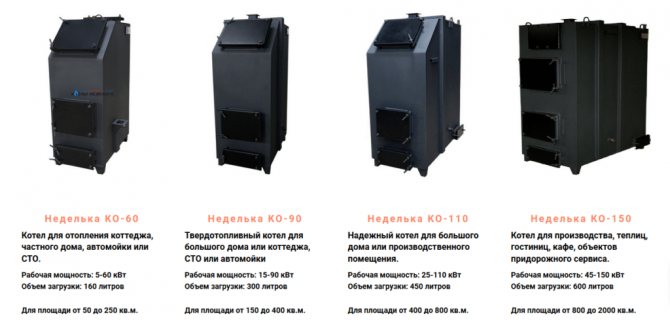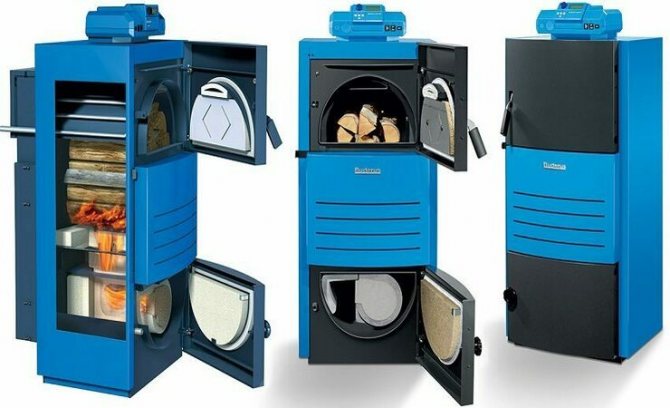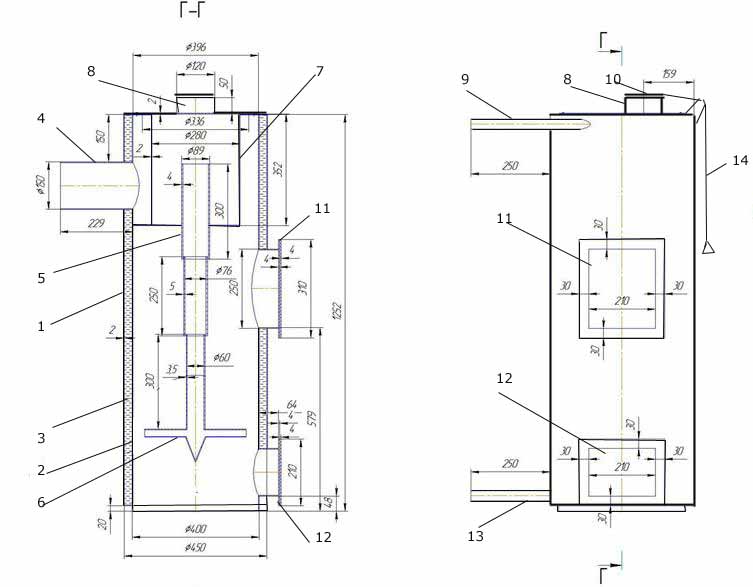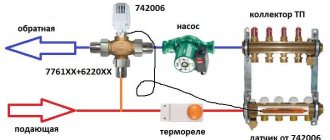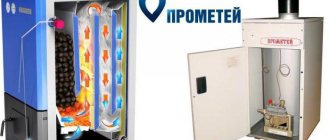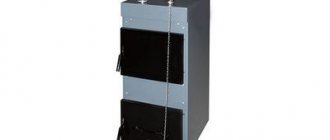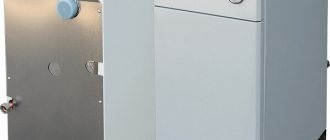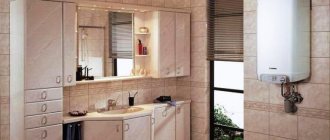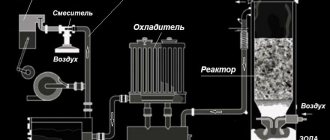Design features and principle of work
The inner part is used as a firebox. It is designed so that combustion occurs from top to bottom. This is facilitated by a special air supply directly to the combustion zone. The process is more reminiscent of smoldering with the production of gases from carbonaceous fuels. To a large extent, these gases are flammable. Due to their afterburning in the upper part of the furnace, the maximum use of thermal energy occurs, which makes it possible to increase heat transfer and reduce fuel consumption.
The boiler chamber is divided into two parts by an air distributor. It has the shape of a pipe, to which a pad with blades is attached at one end, and the other end serves to supply oxygen.
Top-fired boilers are characterized by a cyclical operation, and until the first tab burns out, the addition of a second batch of fuel will not be necessary.
Technical characteristics of solid fuel boilers
Top fired boilers are produced with different capacities from 8 to 95 kW. Some models can reach 1200 kW. The higher the indicator, the more efficient the operation of the unit and the larger the area can be heated. The boilers with the minimum output are designed for installation in small houses. Ukrainian "Burany" with 40 kW are intended for heating large houses or warehouses.

Solid fuel boiler BURAN-EXTRA 1200
Boiler materials are cast iron or steel. A cast iron heat exchanger is more durable, but due to its heavy weight, it can be difficult to install. Steel heat exchangers are made of steel of various qualities from low-grade to high-quality, resistant to high temperatures. In addition, steel boilers are often protected from fireclay bricks.
Most often, top-fired boilers run on wood, but there are models in which you can stack coal, peat briquettes, shavings and other fuels.
The efficiency of the boilers is 85-93%. According to the manufacturers, the operating time of the device after one load of firewood is from 8 to 31 hours, and on coals up to 5 days. An average inexpensive boiler produces heat within 5-8 hours.
Water heating temperature 70 0 C on wood and 85 0 C on coal. The recommended inlet temperature is from 60 0 C. The heating system can be either with natural or forced circulation.
Making a boiler for long burning
To make the installation with your own hands, you will need St 20 steel. The installation made from it will last at least 15 years. With a greater amount of carbon in steel, the material can be hot-hot, so it is not suitable for manufacturing. If possible, you can buy heat-resistant steel alloyed with molybdenum or chromium. From the table you can find out what sizes of blanks will be required for the manufacture of the device.


Sizes of workpieces
To cut the material, it is best to go to a workshop that has guillotine shears. There will be no burrs in the parts, a lot of time will be saved. You will also need the following details:
- Equal corner 50x4 mm. It will be needed to make grates.
- 2 pipes: DN50 and DN The first for the heat exchanger and the pipes to which the heating systems will be connected. The second is for the chimney.
- Pipe 60x40 mm for the air duct channel.
- Steel strip 20x3 mm.
- Basalt insulation.
- Pens.
- Asbestos cardboard and cord.
You will also need tools for metal welding, cutting and some others that are available in every home.


Fan and control unit
The mine boiler will use a control unit, fan, temperature sensor. It is worth finding Polish products that are very similar to Chinese ones, but differ significantly in build quality and service life. Marking of the control unit - KG Elektronik SP-05, fan - DP-02.
Advantages and disadvantages of solid fuel boilers for upper combustion
Top fired boilers have been providing users with heat for over 15 years. During this time, they have fully confirmed their effectiveness, which is ensured by the following factors:
- when the fuel is loaded, the distributor rises up, and after ignition it rests on the wood and falls as it burns out;
- in the place where air enters, incomplete oxidation of hydrocarbons occurs. Gas with ash particles is transferred to the upper part of the combustion chamber. There oxygen joins it, as a result of which it is burned out and gives off the remaining heat;
- at the beginning of the gas combustion chamber, there is a draft regulator. It automatically detects the temperature of the water and regulates the rate of combustion of volatile compounds.
The boilers have the following advantages:
- long operating time and minimum number of downloads;
- energy independence due to work with natural circulation and natural draft;
- the versatility of some units in terms of fuel: coal, firewood, shavings, peat, etc.;
- a small amount of fuel is able to ensure high efficiency of work;
- automated continuous operation of the boiler for supplying hot water and heat;
- the absence of complex mechanisms makes the boiler operation simple even for beginners;
- high level of security;
- long service life of 10-15 years or more.


The upper combustion boiler has a high level of safety
Disadvantages of solid fuel boilers with top loading:
- high cost compared to other installations;
- sensitivity to changes in heat exchanger temperature. Condensation and oxidation of steel elements are possible;
- increased ash content can clog the combustion zone and reduce the level of heat transfer;
- it is necessary to regularly manually clean the chimney and ash pan;
- inconvenient laying of firewood due to design features;
- you cannot load large fuel, for example, not chopped firewood;
- the fuel must be completely dry, so you need to think over the conditions for its storage;
- incomplete loading makes firing up inconvenient; the firebox is deep enough;
- it is impossible to carry out additional loading if the process is already running;
- the support beam and disk, which serve as a partition between the combustion zones of solid fuel and gas, quickly fail.
As you can see, solid fuel boilers for upper combustion are not without drawbacks, therefore, before purchasing such a device, carefully weigh the pros and cons.
PRINCIPE WORKS AND OVERVIEWS
In some cases, a solid fuel boiler remains the only practical way to heat a private ohm. However, classic designs have one very unpleasant drawback, you constantly have to monitor the amount of fuel and throw firewood or coal into the furnace. He hesitated a little or was delayed, and the coolant begins to cool down.
You can develop a habit, create a rigid schedule to ensure constant heating, or you can choose a solid fuel boiler for long burning, which in an extremely simple way can work on one tab for up to several days.
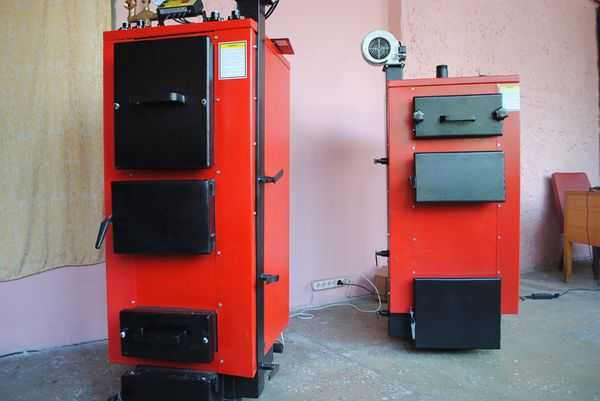

Principle of operation and device
Traditionally, solid fuel boilers, like stoves and fireplaces, used active combustion of wood or coal. Due to the controlled air supply, it was possible to achieve maximum heat transfer and good fuel burnout. However, active combustion too quickly uses the entire volume of fuel in the furnace, from which it is constantly necessary to replenish its amount.
In solid fuel boilers for long burning, the main idea is to slow down the combustion process of fuel. If only one part of the bookmark is lit, then the total volume will be consumed for a much longer period of time.
As an example, it is enough to recall how long a match burns when it is raised with a flame upward, and how it quickly flares up and burns with a flame lowered downward, while burning your fingers. With wood and coal, this principle also applies.
It is necessary to limit the combustion area in one place of the bookmark and maintain it at the minimum required level, preventing the entire volume from igniting.
Long-burning boilers are equipped with a volumetric combustion chamber several times larger than that of conventional designs. Firewood or charcoal is filled up to the top of the chamber, leaving only a small gap. Ignition is carried out from the top of the tab.
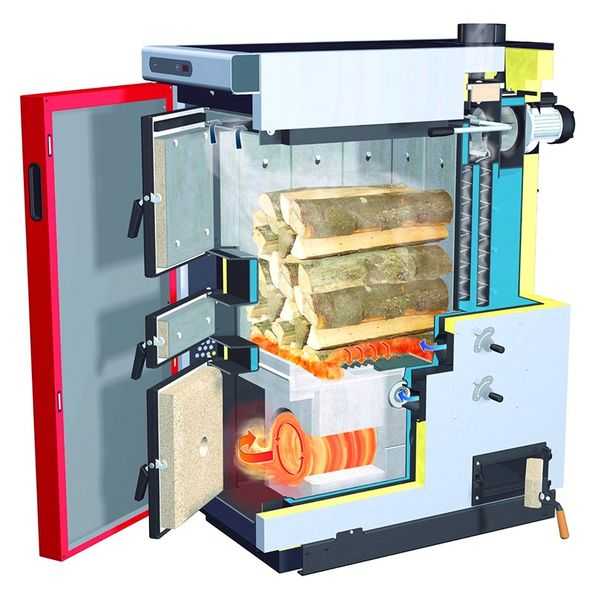

The chamber is insulated in the lower part, the air flow is carried out only from the top, if the boiler is with upper combustion. After the fuel is ignited, all oxygen from the chamber burns out and, in fact, the firewood located below the combustion area is preserved.
The air supply is controlled and strictly limited. As a result, the wood either smolders or burns only in the upper part of the chamber.
A special blower fan is used to supply air, which is installed instead of a standard gate or in a separate seat. Only by controlling the fan, the combustion process of the boiler and the preparation of the coolant are fully controlled, which greatly simplifies the automation of the operation of solid fuel boilers.
By the method of localizing the combustion area, boilers are distinguished:
- with top burning;
- with bottom combustion (pyrolysis).
There is a fundamental difference between the two. Long-burning boilers are, by definition, top-burning, which ensures that the main volume of the bookmark does not warm up. Bottom fired boilers are pyrolysis boilers. Although they stand out in the hotel group, they are also long-burning devices.
When wood is heated above 300 ° C without active combustion, wood decomposition into ash and pyrolysis gas begins, burning which you can get more heat energy than with ordinary active combustion, but with less power.
Active combustion gives a significantly higher heat output per unit of time than top or bottom combustion of the same volume of fuel. To obtain the required power in long-burning boilers, it is necessary to increase the area of weak combustion, to increase the amount of fuel put into the furnace.
This has two main advantages long burning boilers:
- The gradual combustion of fuel is easier to control and the bookmarks are enough for a longer time, moreover, the difference is an order of magnitude.
- It is possible to automatically control and regulate the heat output of the boiler with a gradual fuel consumption.
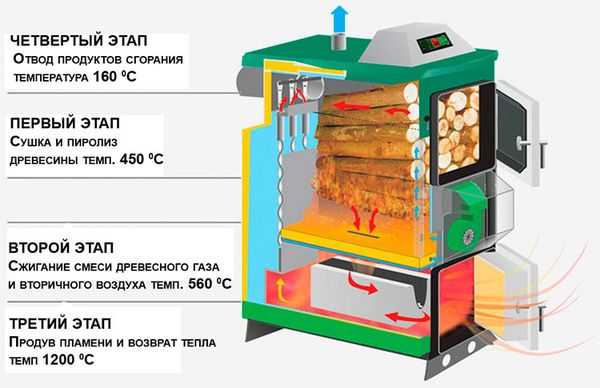

The principle of operation of the pyrolysis boiler
In pyrolysis boilers, a chamber is additionally equipped for burning the released gas. The air supply is carried out separately from the main chamber with a backfill, therefore it is possible to maintain active combustion there with a large heat output per unit of time.
Long-burning boilers with top combustion are often not equipped with grate bars, since there is no need to supply air from below, and ash is easier to remove using a retractable solid pan, moreover, this should be done almost once every several weeks, or even a month.
Only combined boilers and pyrolysis boilers are equipped with grates, in which, in addition to long burning, you can set up the usual classical mode of operation with complete and uniform burning of the bookmark.
Is it true that the download is once a week?
Indeed, some long-burning boilers can work for up to a week on one refueling of wood or coal.However, this mainly applies to heavy-duty units with an output of 150 kV and up to several megawatts. A conventional boiler for a private house is more often designed for continuous operation on one tab for up to 30-45 hours, that is, up to two days.
The main problem is the allowable size of the combustion chamber while maintaining adequate controllability of the entire process. It is necessary to choose a compromise solution between parameters such as:
- chamber volume;
- chamber depth;
- combustion area;
- required boiler output.
With an increase in the volume of the chamber for filling fuel, it is necessary to increase the combustion area, since it will not work to make the chamber narrow and high. In this case, it is difficult to maintain an active flow of air to the combustion zone when it drops too low.
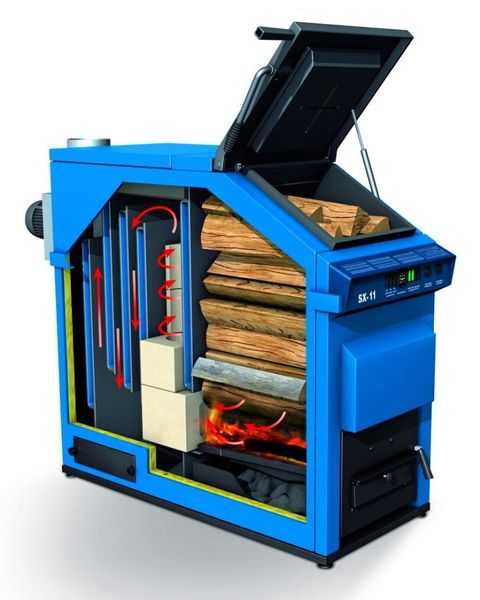

A number of turbulent flows arise that can spread combustion throughout the entire volume and completely bring down the normal operation of the boiler.
Boiler manufacturers first of all start from the required heat output of the boiler, and already on this basis, the dimensions of the combustion chamber are selected as a compromise solution.
Coal-fired boilers work longer on one tab than on wood. For example, if the boiler is designed to operate from one coal load for 17 hours, then when the firewood is laid, it will most likely work only 14-15 hours, with the same heat output setting.
Double-circuit or with a water circuit for the home
Solid fuel boilers for long burning can be equipped with one or two heat exchangers to prepare the coolant for the heating system and hot water supply. At the same time, there are no fundamental differences from the design of conventional solid fuel whales. The circuits can be combined in one bithermal heat exchanger or located separately from each other.
The type and configuration of the heat exchanger is selected by the manufacturer based on the dimensions and shape of the furnace so as to maximize the use of thermal energy for its intended purpose.
Long-burning boilers operate on a smaller volume of air and with a lower temperature of the outgoing combustion products. Heat exchangers are made with the largest possible heat exchange area.
The advantage of long-burning boilers is the ability to control and regulate the thermal power of combustion, only by adjusting the air supply, without regard to the amount of fuel loaded.
If in ordinary boilers it is necessary to limit the portions of firewood or coal and more often to make bookmarks in order to reduce the temperature of the coolant, then in long-burning boilers it is enough to limit the flow of air so that the firewood only smolders.
Ukrainian production
Among Ukrainian manufacturers, the following companies are engaged in the production of long-burning solid fuel boilers: Altep, Buran, Gefest-profi, KOTeko, NEYS, SWaG, Donterm.


Altep KT-1E boiler
Partially presented their own developments, however, in view of the greater experience of European manufacturers, partially or completely the models repeat the successful solutions of Western partners or a licensed assembly is offered on the basis of regional plants and enterprises.
| Brand and model | Power | Combustion type | Fuel | Duration of work | Cost, $ |
| Altep KT-1E 15-45 KW | 15 | Top burning | firewood / coal | 8-24 h | 950 |
| Buran-12 | 12 | Top burning | Firewood / coal / briquettes / waste | up to 30 h | 975 |
| Buran -20 Delux | 20 | Top burning | Coal / firewood / briquettes | Coal-12 days, Firewood-48 h Briquettes - 72 h | 1200 |
| SWaG 20 kW Dm | 20 | Top burning | Coal / firewood / pellets | Coal - up to 5 days. | 1050 |
| NEYS NEUS-B | 10-38 | Top burning | Coal / firewood / pellets | 8-24 h | 750-1200 |
| Donterm DTM KOT-10T | 10 | Top burning | Coal / firewood / briquettes | Up to 48 h | 450 |
Russian production
Solid fuel boilers of Russian production are mainly represented by a number of brands, while the equipment itself is sometimes assembled at the same production facilities.
Among the common brands: Phantom, Teplov, Bourgeois, F.B.R.Zh., Zota, Wester, Don, Sibenergoterm (Prometheus), Tepoldar (Cooper PRO), Buderus.


In almost all cases, long-burning boilers or pyrolysis boilers are a revision of the classic layout with an increase in the furnace and restructuring of the air supply system.
However, models such as Prometheus or Zota boast a unique design of a heat exchanger and a combustion product removal system, focused specifically on the pyrolysis of the lower or upper combustion of fuel.
| Brand and model | power, kWt | Combustion type | Fuel | Duration of work, h | Cost, thousand rubles |
| Bourgeois-K T-50A | 50 | Pyrolysis / firewood | firewood | 6-12 | 138/149 single-circuit / double-circuit |
| Bourgeois-K T-150A | 150 | Pyrolysis / firewood | firewood | 6-12 | 315/336 single-circuit / double-circuit |
| ZOTA “Carbon” | 15-60 | Bottom burning / coal | coal | 10-12 | 40-84 |
| Teplov T10 | 10 | Pyrolysis / firewood / coal | firewood | up to 12 | 40/44 single-circuit / double-circuit |
| Teplov T100 | 100 | Pyrolysis / firewood / coal | firewood | up to 12 | 190/210 single-circuit / double-circuit |
| Phantom Max 30a | 30 | Pyrolysis | firewood | up to 20 | 100 |
| Phantom Max 90 a | 90 | pyrolysis | firewood | up to 20 | 236 |
Boilers Stropuva
The company Stropuva, established in Lithuania since 2000, is engaged in the production of long-burning boilers and ready-made solutions for autonomous heating systems with automatic control. Boilers have a specific appearance due to the significantly increased volume of the combustion chamber, moreover, for the most part upward.
The shape of any model is a tall cylinder, inside which a volumetric chamber, an air supply system and heat exchangers for the heating and hot water circuit are assembled. The design and principle of operation of the Stropuva boilers are patented, so it is hardly possible to find an analogue, however, on the market already now you can find a lot of fakes, strongly stepping on the characteristics and quality of the originals.
STROPUVA IDEAL boilers are a universal solution for working with wood, coal, fuel briquettes. The main feature is the presence of perfect automation, which allows you to set the operating modes of heating equipment with high accuracy. However, this line includes only 20 and 40 kW models.
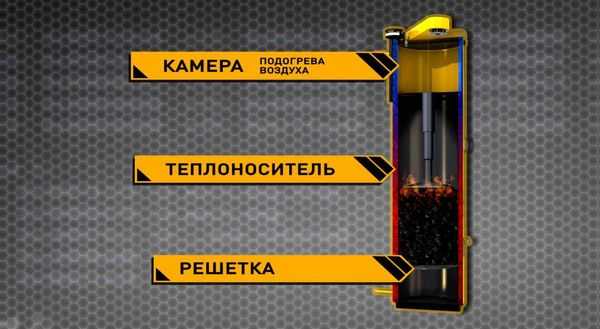

Boiler device Stropuva
STROPUVA boilers are universal - boilers for burning almost any type of solid fuel from wood waste to coke and coal. Partially automated, mainly in terms of maintaining a long-term burning mode. The model range is represented by boilers with a capacity of 10 to 40 kW.
STROPUVA wood-fired boilers are a simple solution in cases where the main type of fuel is, by definition, wood. The list of models starts with a power of 7 kW, as an excellent solution for a small country house or summer cottage.
How to choose
The main criterion for choosing a long-burning boiler is its rated thermal power, moreover, when using the main type of fuel.
After that, you should pay attention to:
- combustion chamber volume;
- operating time from one load;
- version and availability of automation;
- the possibility of using other types of solid fuels;
- number and characteristics of heat exchangers.
It is not worth counting on the fuel load, which will last for a week in boilers positioned for a private house. The optimal battery life is from 17 to 45 hours, which is quite suitable for private use.
udobnovdome.ru
Nuances of the upper combustion boiler control system
In long-burning top-burning boilers, the main control principle is the regulation of air flows entering the combustion chamber. The standard units are equipped with a mechanical device for this. The chain-driven damper is actuated by a thermostat.
The thermostat in the boiler is adjusted to a certain temperature regime.When the heating medium heats up to the required level, the damper is automatically set to a certain position, reducing the heating intensity. It is impossible to drastically reduce the temperature, because the coolant will continue to heat up by inertia, heating the room.
Devices with fans work a little differently. If you need to increase the power of heat transfer, then this can be done precisely at the expense of the fan. The appliance will blow air. Due to it, it is possible to reduce the inertia of the boiler. The control takes place automatically, and the sensors record the slightest changes in the temperature of the coolant.
Materials for assembling a shaft-type boiler
To make a mine-type pyrolysis unit with your own hands, you need to prepare:
- Steel sheets lined with a thickness of 3-5 millimeters. You should not use another type of steel, since pyrolysis takes place at a high temperature and a conventional alloy will quickly burn out.
- Sheet steel having a thickness of 1 to 2 millimeters.
- Fireclay brick.
- Pipes with a diameter of 25 and 135 millimeters.
- Corners 4x4 centimeters or a profile pipe of the same size.
- Double ash door, preferably with an asbestos gasket.
- A valve designed to regulate the air supply.
- A door for cleaning the heat exchanger chamber.
- Gate valves - 3 pieces: one is needed for the chimney, the second is placed between the chambers on the partition, and the third is required to regulate the flow of air into the combustion chamber.
- Basalt wool.
- Galvanized sheet.
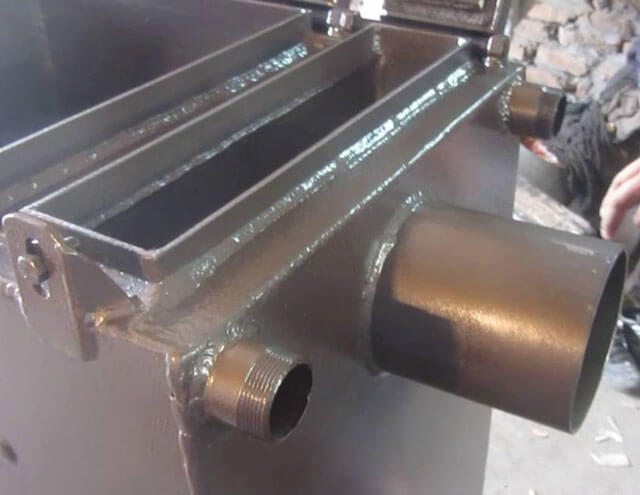

But, before you go shopping for building materials, you should calculate the minimum power of the unit. Then they begin to develop the drawings of this device.
You can use ready-made calculations and boiler diagrams. When choosing a drawing, special attention should be paid to the volume of the combustion compartment. The larger this value, the more prolonged the combustion will be.
Review of the best top-firing boilers
Currently, the production of solid fuel boilers has expanded significantly and many models of foreign and domestic firms are presented to the choice of consumers. Let's take a look at the best ones.
Stropuva
The boilers of the Bulgarian company Stropuva are compact units with high efficiency. The devices are equipped with a blower fan. The cylindrical body has a shaft structure. The devices are characterized by excellent performance combined with excellent design. Universal boilers can be heated with wood, peat or pressed briquettes. The power of the models is 8-40 kW, the heated area is 30-400 sq.m. The permissible moisture content of the fuel can reach 45%, which is fully consistent with modern requirements.
Liepsnele
In Lithuania, long-burning boilers are manufactured on solid fuel of a universal type, i.e., operating on any type of fuel. The power of the units varies in the range of 10-40 kW, the heated area is up to 400 sq. M. The maximum operating time on one coal laying is up to 7 days, firewood - up to 2 days. The design of the boilers is a classic mine type with top combustion. Liepsnele boilers have a high efficiency, not less than 90%, regardless of the type of fuel and the choice of operating mode.
Week
The boilers are rectangular in shape, have an attractive design and compact dimensions. For a more complete heat removal, channels are provided through which heated flue gases pass. Russian top-fired boilers capable of operating on one coal load for up to 7 days.


Boiler week
The company Nedelka offers four variants of boilers with different capacities, assuming heating of premises of different sizes: 50-250 sq.m., 150-400 sq.m., 400-800 sq.m., 800-2000 sq.m.
For water heating of a private house, many designs of heating devices have been developed. Mine boilers stand out for their efficiency and low maintenance.Their cost is quite high, so many craftsmen repeat factory models at home or make them according to their own design.
A mine boiler of long burning differs from others in the duration of combustion and in the features of the device. Often it is not required to add fuel, it has a large fuel chamber, and combustion is slow. Two types of mine boilers have been developed: with conventional combustion and pyrolysis. Each has a similar device of two chambers: one burns fuel, the other has a heat exchanger.
A mine boiler with conventional combustion is simpler in design. Half of the entire volume is occupied by a firebox with a height of almost the entire unit, but of a small width and depth. On the side or on top there is a hatch for loading fuel. When viewed from above, the combustion chamber resembles a mine, hence the name. An ash pan is located under the combustion chamber, separated from it by a grate. Through the ash-pan door, access opens not only to it, but also to the firebox. The air intake is regulated by a gate located under the door.


The mine boiler does not require special control due to its burning duration
The second important part is a chamber with a heat exchanger filled with water or, if the boiler is not used for hot water heating, a fire tube. Gases enter it from the firebox through the hole and exit through the chimney, simultaneously heating the heat exchanger. From it, water enters the system through pipes or hot air heats the room.
A shaft-type pyrolysis boiler has a similar design, but is manufactured with some additional elements:
- 1. Chambers in which carbon monoxide burns and burns out. Located at the bottom of the heat exchange space, the walls are lined with fireclay bricks.
- 2. Several pipes with many small holes. Through them, air is supplied for the combustion chambers and afterburning.
- 3. At the top of the wall there are valves for separating the two chambers.
The principle of operation of the pyrolysis boiler is somewhat different. During the firebox, the flow of air is limited, slow combustion causes the formation of a large amount of gases that enter the additional chambers and burn out. Boilers burn any solid fuel: coal, wood, pellets. One load of coal is enough for five days, firewood - no more than thirty hours. Due to complete combustion, such boilers have a high efficiency - up to 90%.
The proposed design has a power of 22 kW, an efficiency of 75%. It works on wood for 10 hours without additional loading, on coal - for a day. The firebox has a volume of 83 liters up to the lower edge of the loading opening. The boiler is equipped with Polish-made automatics: a control unit with a KG Elektronik SP-05 temperature sensor and a DP-02 fan. General view is shown in the drawing.
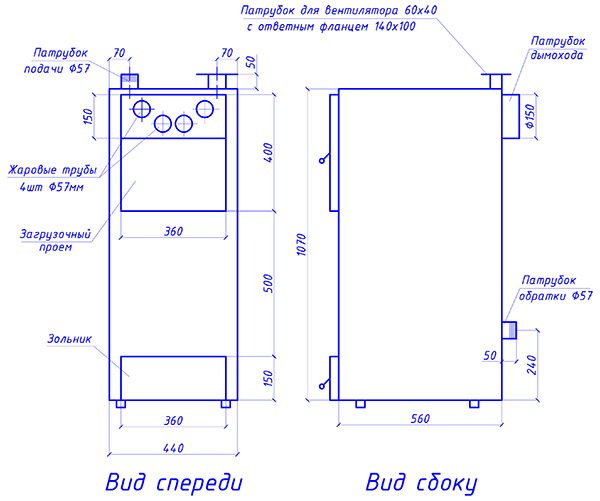

The device works as follows:
- 1. Firewood is loaded into the firebox and set on fire. The doors are hermetically closed.
- 2. The required heating temperature is set on the control unit, not less than 50 °. The unit button is pressed and the fan starts to blow air.
- 3. When the set temperature is reached, the air supply by the fan stops. Firewood smolders slowly, they give very little heat.
- 4. After a while, the temperature drops. The fan switches on again and combustion continues.
The electronic unit regulates the combustion process, which takes place at maximum efficiency. There is practically no smoldering, intensive combustion and standby modes are used.
The following figure shows an inside view.
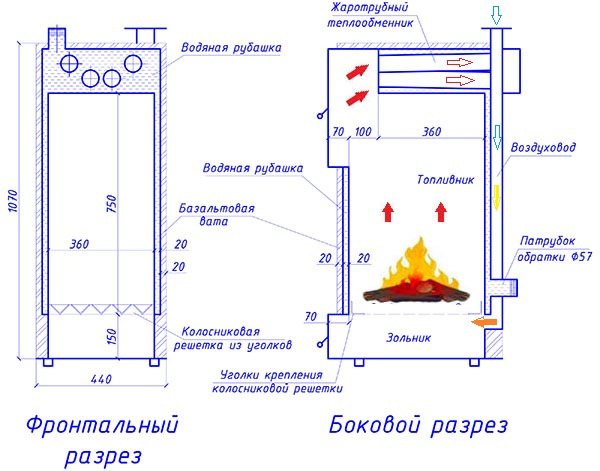

Solid fuel is burned according to the classical scheme: heat is directly transferred to the walls of the water jacket and the roof of the tank. It has a built-in heat exchanger that takes heat from the gases. Heated air is fed into the firebox through the air duct from below. The fuel loaded in large quantities ensures a long operating time of the boiler.While waiting, when the fan turns off, the air is completely blocked off by a gravitational damper, triggered by automatic equipment, the natural draft is blocked.
The drawing shows the rear with a flame tube heat exchanger.


When assembling with our own hands, we use the drawings, we adhere to the specified dimensions. The sequence is as follows:
- 1. Cut out the body from 4 mm metal: bottom, side walls, lid, doorways. Everything sticks to the bottom, which is released to the sides, as in the drawing. Inside, we fix the corners by welding, which will serve as a shelf for the grate.
- 2. Carefully weld the joints and proceed to a 3 mm metal water jacket. It retreats from the walls of the body 20 mm and, to install it, we weld steel strips onto the body. We weld the skin to them.
- 3. Installing the flame tubes on top of the boiler. We cut holes in the back and front walls, insert several pipes, weld at the ends.
- 4. Cut out the doors, weld two strips from the inside, put asbestos between them for sealing. We cut the grates of 360 × 460 mm from the corners and weld them to the shelves with an outer corner.
- 5. In the walls of the tank we cut the fittings on the supply and return pipelines, the branch pipe of the smoke channel. We weld an air duct from a 40 × 60 mm profile pipe. A fan will be attached to it through the flange. The air inlet is through the back wall.
- 6. We weld on the door hinges and tabs for attaching the decorative frame. We wrap the boiler tank with basalt insulation, fasten it with a cord. We fasten the frame with self-tapping screws to the tabs, install the doors.
Principle of operation
The peculiarity of the operation of horizontal and vertical structures is that when fuel is burned, air is heated, which, as it rises, is discharged through the chimney. At the same time, in the process of transferring heat from the heated air, cold water is heated in the heat exchanger.
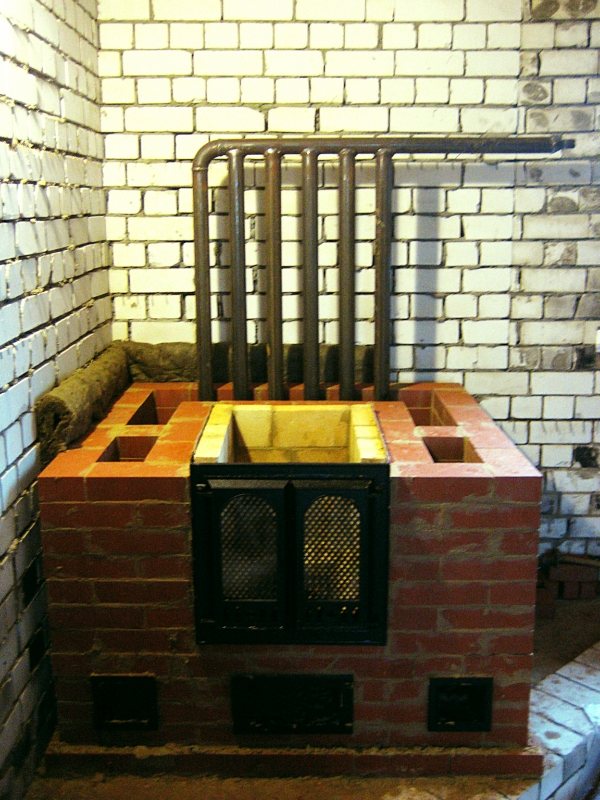

Also, there is another type of heat generator, in the form of a mine boiler. This design differs from the others in the vertical arrangement of the large loading chamber. At the same time, the fuel burns at the bottom of the mine, and hot air and smoke come out through the second chamber, where the heat exchanger is located.
What is needed
First, it is worth deciding on the dimensions of the future solid fuel boiler and choosing the most suitable design. Of course, knowing all the aspects of building brick heat generators, you can design and build everything yourself.
However, in the absence of proper knowledge, it is better to carefully read and choose an option from those presented on the Internet.
It is immediately worth noting the fact that when building a solid fuel boiler made of bricks with your own hands, you will have to face welding work, since the heat exchanger is made of pipes or sheet metal.
If you wish, you can buy a ready-made heat exchanger in a specialized store, then you can do without welding.
Materials (edit)
So, from the materials for building a solid fuel boiler made of bricks, you will need:
- Cement and foundation reinforcement. If a brick foundation is planned, then an additional amount of brick and pebble breaking will be required.
- Fireclay bricks and mortar for laying the furnace.
- Pipes and sheet metal for the heat exchanger.
- Doors and grate.
- Water pump.
- Water heating device.
You will also need tools such as:
- Welding machine.
- Grinder, gas cutter, electric drill.
- A marker that will be used to mark up sheet metal.
- Level, pliers and tape measure.
In addition, do not forget about personal protective equipment in the form of gloves, glasses and a mask to protect yourself during work.
Heat exchanger preparation
To build a brick boiler with your own hands, you first need to prepare a heat exchanger so that you can remove the dimensions for the combustion chamber from it. That is, you will either have to buy a ready-made heat exchanger, or design it yourself.
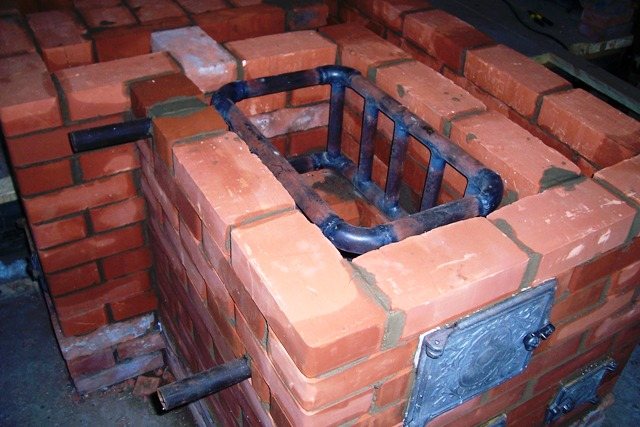

For example, deciding to make a horizontal type heat exchanger from pipes, you will need:
- First, prepare pipe sections of the required size.
- Further, holes are cut out of the rectangular pipe in the corner posts, with the help of which the transverse pipes will be joined. The holes are made with a diameter of 50 mm on the edge of 60 mm. In total, there are 4 holes in each rack. 2 more holes are made in the front wall. One is done from below and is required for the return. The second from the top is for hot water drainage.
- After that, you need to weld the struts to the transverse pipes at an angle of 90 degrees.
- The underwater and branch pipes are also welded, and then the ends of the rectangular pipes are welded.
Also, a horizontal heat exchanger can be made of steel and pipes. The principle of performing all the work is similar to the above-described option, except that in this case the corner posts, as well as the longitudinal pipes, will be replaced with hollow walls.
A vertical type heat exchanger provides not only the possibility of transferring heat to the room, but it is also possible to install a stove with one burner on it. The location of the chimney will depend on its presence or absence.
That is, if you plan to install a burner, then the pipe is installed only on the side.
There is also one more important point that must be taken into account when installing a stove on the stove - there should be no pipes in the upper part of the heat exchanger.
Step-by-step construction of the boiler
A brick body for a solid fuel boiler is laid in the same way as a conventional stove. The dimensions of both the housing and the heat exchanger depend on the dimensions of the heated area.
In addition, the boiler piping scheme must be selected in accordance with the complexity of the system, the number of circuits and the presence of any additional equipment.
To install a solid fuel brick boiler, you can adhere to the following steps:
- The foundation is poured to the size of the heat exchanger.
- Next, a waterproofing layer of roofing material is laid on the foundation, on top of which an oven solution is applied.
- Then the first row is laid out, made of refractory bricks, on which the lower part of the furnace chamber and an ash pan with a door, separated by a grate, will be located.
- Further, a heat exchanger is installed on the laid out base so that it goes uphill to the point where hot air will be drawn. Also, in order to avoid the formation of air plugs in the future, between the brick and the heat exchanger, there must be a gap of at least 10-30 mm.
- A door is attached to the front for loading fuel into the firebox, and a place for the chimney is left behind.
- A hob or a thick sheet of metal is laid on top of the combustion chamber, on which a layer of brick is placed or the vault of the chamber is laid out.
- The chimney can be located on the side or on top of the combustion chamber. Moreover, it can be made both of an iron pipe and a brick.
- Further, a smoke damper is installed in the body of the chimney.
- After the masonry dries well, you can install the water circuit. Pipes with water are supplied to the heat exchanger, which are connected to the heating radiator using couplings or welding.
- Next, a trial run of the heating system is done and if everything is in order, then you can start finishing the stove with plaster or tiles.
Working principle of wood heating boiler, long burning
The device and principle of operation of a wood-burning boiler for long-term operation from one load is aimed at recreating such conditions in the limited space of the combustion chamber.Firewood does not burn in the full sense of the word, but smolders. The operating time increases, and the lack of heat is compensated for by the afterburning of the released gases.
The design of long-burning boilers includes the following units:
- Combustion chamber - the device has two combustion chambers at once. The first furnace (with vertical or horizontal loading) is designed for wood burning. The second chamber is used for afterburning the produced carbon dioxide. To ensure complete combustion of gas, the firebox is made of fireclay bricks, which prevents heat loss and helps maintain a temperature of about 800 ° C.
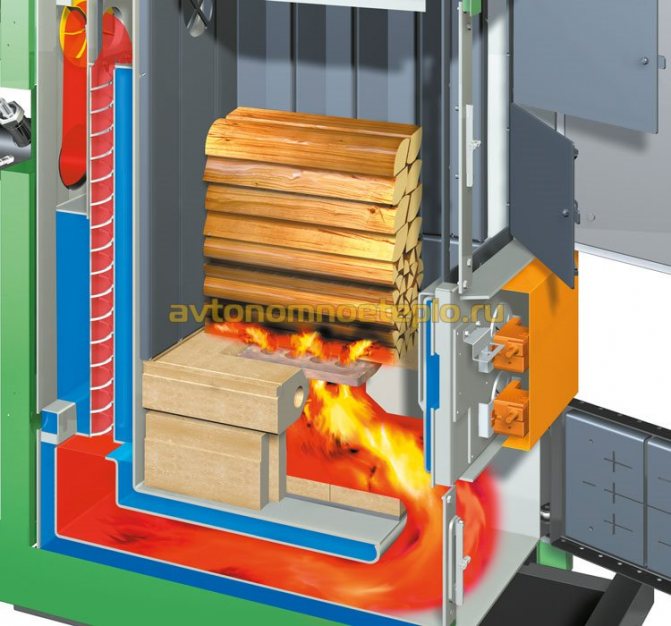

How to choose a slow burning wood burning boiler
Long-burning wood-fired heating boilers are offered by several domestic and foreign manufacturers. The design of the equipment, as well as the heat engineering characteristics, differ significantly. When choosing a heat generator, pay attention to the following parameters:
- Performance.
- Design features.
- Manufacturer country.
According to the three parameters listed above, a suitable boiler model for domestic needs is selected.
Power calculation
A properly selected wood-burning heating boiler for long burning, easily copes with heating living space up to 400 - 500 m². When choosing, the performance of the heat generator is taken into account. Power calculation is performed as follows:
- Calculate the total area of the house.
- Calculate the required power of the boiler using the formula 1 kW = 10 m².
- If a DHW circuit is present in the structure, 15-20% of the reserve is added to the result obtained.
The above calculations are suitable for buildings with an average degree of thermal insulation, located in the middle latitude of Russia and having a ceiling height of no more than 2.7 m. For rooms with a complex configuration, a large number of window and door openings, calculations are carried out using online calculators.
Features of operation of wood boilers with long burning
The burning time of one bookmark of firewood is from 8 to 24 hours. The battery life depends on several factors:
- Boiler type.
- Fuel quality.
- Correct operation.
Learning how to properly heat the boiler is much easier than it might seem at first glance. During firing up and further operation, they adhere to the requirements specified by the manufacturer in the technical documentation. After a few fireboxes, the process becomes familiar.
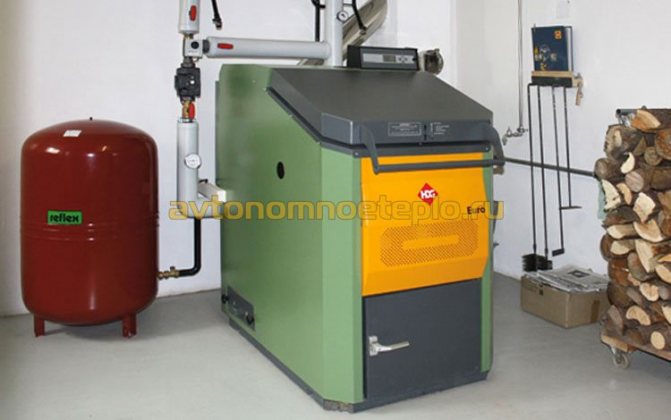

How to achieve long burning firewood
You can achieve long-term burning of firewood by carefully following the manufacturer's recommendations:
- Firewood is ignited with the damper fully open.
- The boiler is switched to the long burning mode only after reaching the temperature of 600 ° С.
- The moisture content of the wood should not exceed 20%. Heating with conifers is not recommended.
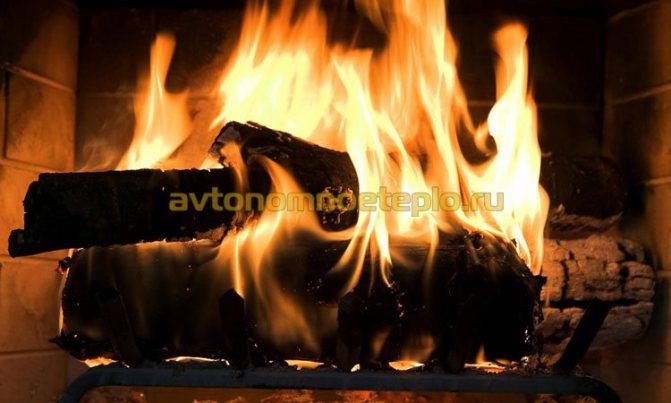

Violations of the operating rules lead to the formation of resin from the wood in the boiler. Most often, the following conditions are not met:
- The minimum temperature of the coolant at the outlet should not fall below 65 ° C.
- It is correct to heat the boiler with hardwood firewood: aspen, beech, acacia, oak, etc.
- The high moisture content of the wood leads to an abundant release of resin.
Correct operation of long-burning boilers prolongs the service life of equipment and increases heat transfer.
How to load firewood correctly


The ignition is carried out exclusively with dry splinters. It is prohibited to use gasoline or kerosene for kindling firewood. From time to time, it is recommended to use special chemical briquettes that remove tarry deposits on the walls.
How much firewood is needed for the winter season
The device of the boiler for long burning, allows saving on fuel, approximately 15-30%, depending on the selected model. The approximate consumption of firewood is calculated as follows:
- It is generally accepted that for heating every 100 m², 3 Gcal / month will be required.
- When a kilogram of firewood is burned, 3200 kcal are released.
- To obtain 1 Gcal, long-burning boilers burn 312 kg of firewood.
- To obtain 3 Gcal, you will need about a ton of wood.
During the heating season, to heat a 100 m² house, you need 7-8 tons of firewood.
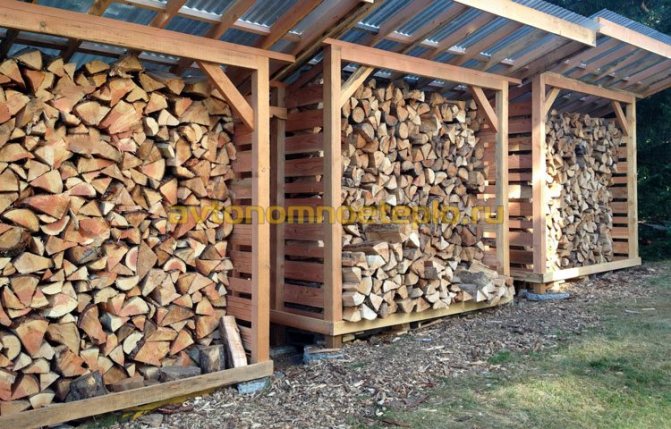

Rules and regulations for the installation of a long burning wood boiler
The installation of a long-burning boiler is carried out in compliance with the standards applicable to all boilers operating on wood. During the installation work, take into account the existing requirements of PPB and SNiP:
- Installation is carried out on a solid, non-combustible base. Walls and floors are covered with non-combustible building materials.
- The chimney is carried out in compliance with the fire cuttings. At the junction to the wall made of combustible material, fire-resistant insulation is laid. The material is lined with steel sheet.
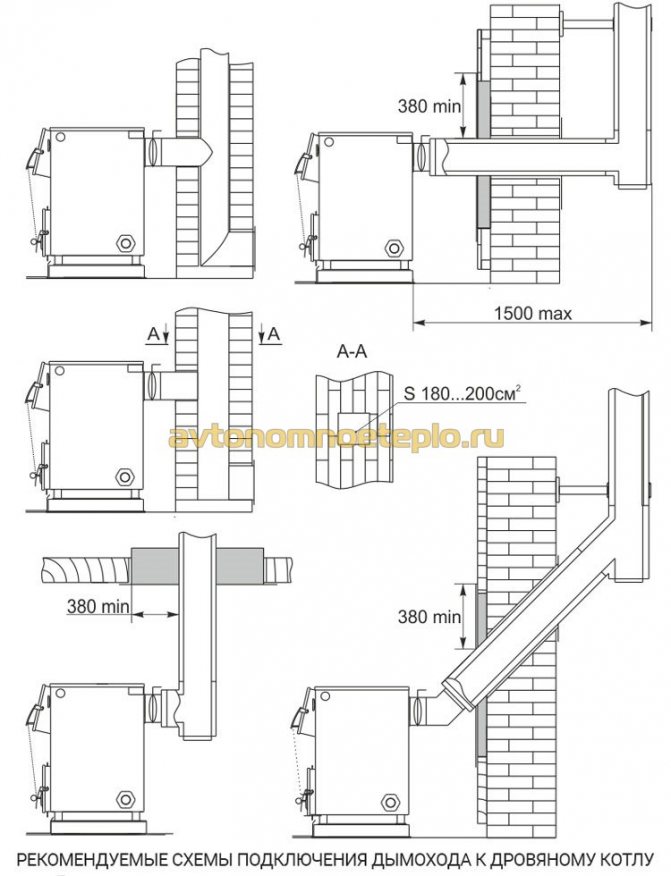

Water heating from a long-burning wood-fired boiler is connected to special outlets located on the boiler body. The instructions indicate in detail which branch pipe goes to the supply and return of the water circuit.


- A boiler with a capacity of more than 40 kW is installed in a separate room.
- Volatile boilers are connected to the power supply through a stabilizer and an uninterruptible power supply. Be sure to use machines. The connection is made directly from the control room.
In the room used for the boiler room, it is necessary to have supply and exhaust ventilation and natural light. If necessary, it is allowed to place the boiler in the basement.
